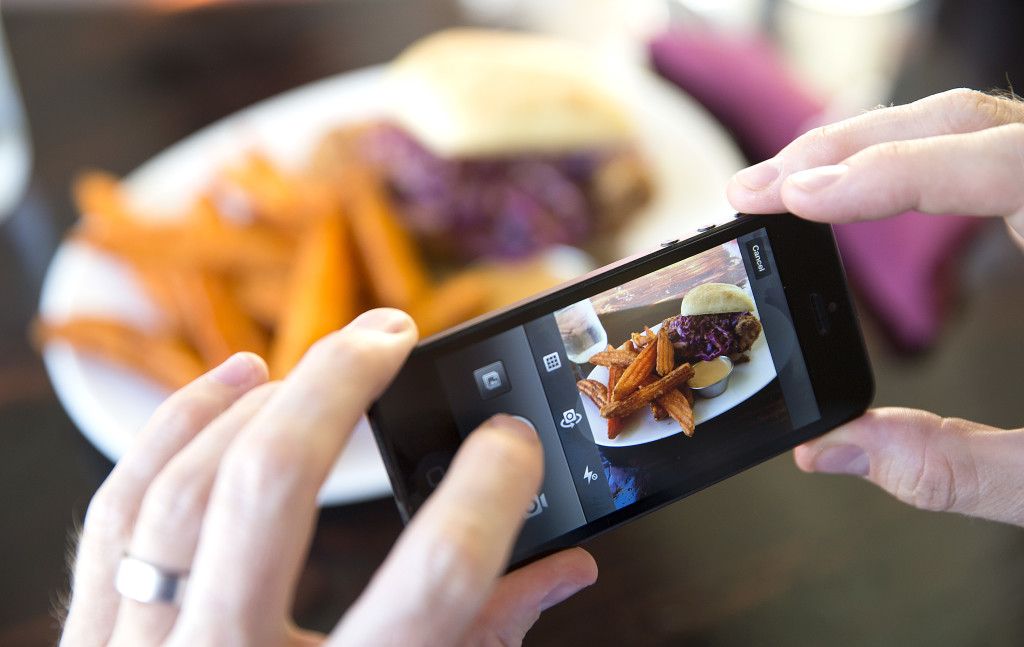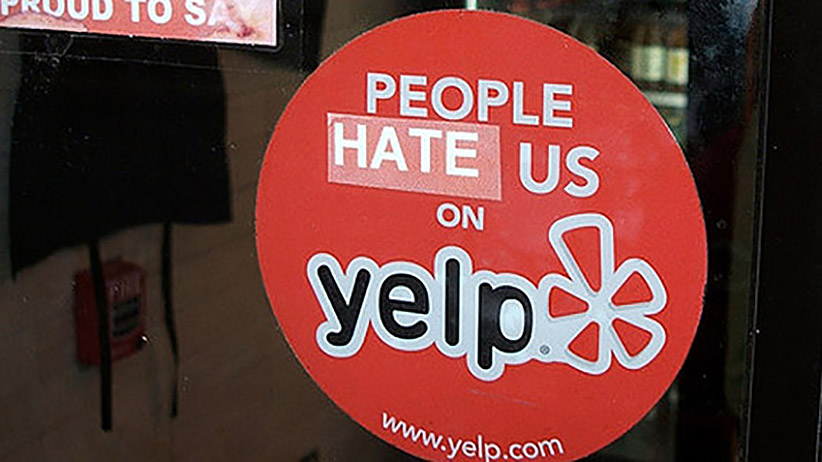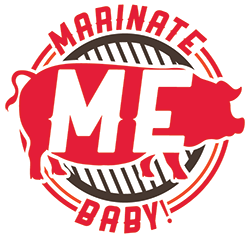
Yelp has an interesting user base. Those who are active posters and those who follow Yelp reviews to help them inform their dining choices. This is an emblematic experience I suppose for the world of social media. What differs in regular social media is the lives that it effects – for the good and the bad. Think of Yelp as a digital version of Kitchen Nightmares. If there are horrific establishments that are causing serious health concerns or service issues then this tool can be very positive to the public’s right to know. The balance with all journalism the question prevails perspective. Perspective from the point of view was the bad service just a bad night or a serious lack of institutional control by the management and ownership? Yelp has a financial influence in this game as well. Ultimately we will talk about how you can use Yelp as a tool for good and how to sift out the crap.
On a regular basis, generally around Valentines Day (one of the biggest days of the year in the food business) Yelp posts a story about the Top 100 Places to eat in the US for 2016. It made a splash in the food based blogs, regional sites and some television stations covered quick stories about the local restaurants that were named. Twitter started to fill with self-congratulatory tweets from businesses, journalists and notable diners.
Can we focus on the list isn’t that great? Let’s set aside the regional bias to the various ‘foodie’ cities. It also is just bad journalism. The list is just lazy journalism, it poaches other people’s work and creating a list naturally attract people like a moth to light. I will give Yelp some credit, they do have data from hundreds and thousands of people to draw up on. The issue I continue to see is their criteria for the list of “businesses that rank so highly in the Yelp community’s opinion that have earned the status of ‘must try within this life time.”
First, let’s tackle the bias of the list as 45 of the 100 are in California. So, they are saying that almost half of all of the spots that you must try within this lifetime are in California?? Why are only 19 states listed in this list? 66 out of the 100 are on the West Coast of the US. 31 states do not rank in the 100 – so according to the Yelp community there are no establishments in these states that warrant mention – or is it something different?
The Yelp Activist

Photo courtesy of byu.edu
In the restaurant industry there are unheard voices from both the front-of-house and back-of-house and there is an interest into what really goes on behind the the scenes at your favorite establishment. Do to the intensity and impact to their businesses, Chefs and Owners do read Yelp reviews. Notable that most read these reviews when their restaurant first opens to help gauge what people are talking about the establishment for better or worse.
Many food professionals, like you take their job seriously. People feel responsible for the product they turn out and ultimately they know there is going to be a judgement for their work. When you read reviews about your own work it is human nature for that attitude of seeking knowledge about what people are saying tends to turn sour, very quickly and you start to feel like someone has insulted a family member or made an attach on one of your children.
The issue comes when a ‘Yelper’ or a collective of ‘Yelpers’ decide to hit an establishment and all leave reviews based on a single visit. When solo visit reviews are posted, it doesn’t take into account if the FOH or BOH is having a bad day. It also doesn’t take into account that many Yelp reviews are dated and when there are positive reviews with pictures and the menu has changed and reviews start to pop up that “This place is overhyped” or “It didn’t live up to the hype from my Chef Friends.” This means the establishment is being judged on a preconceived notion that he was going to hate it, and then actually hated it.
When reviews are years old and Yelpers are responding on their experienced based on those reviews that are years ago – and expect the same meal is just crazy.
Food professionals really do everything they can to please people and to ensure that patrons are well-provided for. If people do not like things in the restaurant, owners will gladly replace them or take them off their check. However, if they do not hear about it in the restaurant it is impossible for them to do anything about it.
The problem is that Yelp reviews are very subjective and not always the most accurate representation of a restaurants service and their staff.
The Customer is Always right? Right?
In 1941, Duncan Hines who is known for boxed cake mixes, placed his first restaurant guidebook for purchase. It was called “Adventures in Good Eating.” Duncan’s intention was to provide “travelers and protect them from eating poisonous food from unsanitary places,” as quoted from his biography.
Today, reviewing is a much more complex system today. The Internet is an integral part of the food business. Yelp and other online review systems such as TripAdvisor and OpenTable have become popular lately. These systems, while they are unique in their approach, they do share a collective goal – to guide customers in the right direction and inform them about what they are getting. That being said, reviewers are different, each write with different points of view and preferences.
Reviewers are encouraged to speak candidly, the threat of this keyboard journalism that uses online review systems as a tool for malice does not align with the core values of each of these companies. This conflict builds tension. Yelp has become the leader in this issue, as the “Yelp” threat has become legitimate.
Yelp has a founding principle, “to connect people to great local businesses by allowing folks to read and write reviews of their consumer experiences,” according to a Yelp Executive.
Yelp is now in 29 countries. Yelp reports 135 million unique monthly visitors. The majority of the reviews are five and four star reviews. Yelp cites that most people are inclined to write more positive reviews, the negative ones tend to stick out.
Establishments are now using the Yelp App as apart of their morning routines. Chef’s who are learning to take the experience in it’s proper context do not get overly excited or deflated about any of the reviews. Chefs/Owners are really looking for trends; if there is a review that cites the steak was flavorless, that doesn’t get much attention. However, if they see that three or four times in a week they know there is a problem. These places know the goal is in responding to the Yelp review to improve the overall experience for guests and to give them a reason to want to return.
Successful establishments actively respond to both positive and negative feedback. Feedback in all their forms help to improve the overall experience for their guests. It is widely held that the service staff feel it would be more beneficial if they could actually have a conversation with the reviewer to get more detail about their experience. Restaurants actually want to build relationships with the reviewers.
Yelp’s and their Business Model

Image credit: truthiscool.com
In and article from the East Bay Express an article by Kathleen Richards points out the fact that “Local business owners say Yelp offers to hide negative customer reviews of their business on its website… for a price.”
One East Bay restaurateur was pitched “for $299 a month” Yelp would move the negative reviews. In addition Ms. Richards reports that several businesses who advertise with the online review site had their review rankings improve drastically.
The article contends that ‘such tactics may be legal, but they clearly raise ethical concerns. Yelp touts its website as consisting of “real people” writing “real reviews.” Richard continues, “The allegations of business owners who have tangled with the company suggest otherwise.”
Conclusion
Here is how I approach the Yelp app and hopefully it will help you make the right decision when dining out and write better and more meaningful reviews while using the application.
Reading and Using Reviews to influence buying decisions:
- Look at trends on the yelp.com version of the service: Look for the last 10-20 days of reviews to determine if you are getting an accurate description of service and local menu choices.
- Don’t take the reviews as gospel: Build your own experience by actually going there and have no preconceived notions that you are going to love or hate it before you walk in.
- Talk to Your Friends: Build a network of friends that you trust, ask their opinion if they have gone there and what they would recommend for you. This will help you know if they know you, know your likes and if you should trust them or not.
Writing Meaningful Reviews:
- Offer Some Background: Offer as much information about the restaurant you are writing the review on. Location, phone number, type of cuisine, hours etc. Fill out if the establishment serves alcoholic beverages or takes reservations. If another reviewer has posted the wrong hours, change the information yourself or inform the website directly.
- Give Both Pros and Cons: Maybe your food was less than stellar, however the Service was Amazing! If your experience had both pros and cons, make sure you list them both too provide readers with the most accurate, well-rounded review.
- Name Specific Entrees: Most diners appreciate specific recommendations and if you loved or disliked the food. Listing specifically what you had ordered will help validate your opinions.
- Evaluate the Entire Experience: There are several factors that can impact the overall dining experience and not limited to ambiance, decor and service are important to note. How quickly did you receive your food and was the server attentive to you. Be specific as possible about the details of the restaurant.
- Use Descriptive Adjectives: Use descriptive adjectives – dont just say it was “BAD” cite it was “Dry, bland or too salty” You can never provide too much detail in a restaurant review.
- Let your Personality Show: No one wants to ready boring and dull reviews of anything. There is no value added or insight if you simple copy what other people write. Make the review personal and unique to you, use your own voice, your readers will be much more interested if they can sense you are being genuine.


